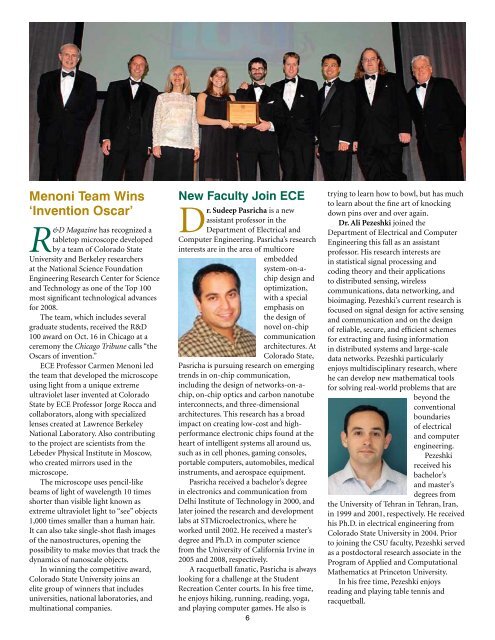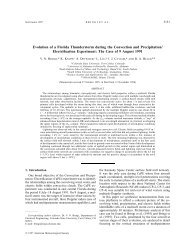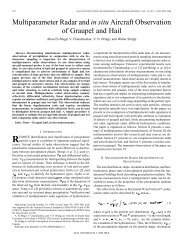News - Radar & Communications Group - Colorado State University
News - Radar & Communications Group - Colorado State University
News - Radar & Communications Group - Colorado State University
Create successful ePaper yourself
Turn your PDF publications into a flip-book with our unique Google optimized e-Paper software.
Menoni Team Wins<br />
‘Invention Oscar’<br />
R&D Magazine has recognized a<br />
tabletop microscope developed<br />
by a team of <strong>Colorado</strong> <strong>State</strong><br />
<strong>University</strong> and Berkeley researchers<br />
at the National Science Foundation<br />
Engineering Research Center for Science<br />
and Technology as one of the Top 100<br />
most significant technological advances<br />
for 2008.<br />
The team, which includes several<br />
graduate students, received the R&D<br />
100 award on Oct. 16 in Chicago at a<br />
ceremony the Chicago Tribune calls “the<br />
Oscars of invention.”<br />
ECE Professor Carmen Menoni led<br />
the team that developed the microscope<br />
using light from a unique extreme<br />
ultraviolet laser invented at <strong>Colorado</strong><br />
<strong>State</strong> by ECE Professor Jorge Rocca and<br />
collaborators, along with specialized<br />
lenses created at Lawrence Berkeley<br />
National Laboratory. Also contributing<br />
to the project are scientists from the<br />
Lebedev Physical Institute in Moscow,<br />
who created mirrors used in the<br />
microscope.<br />
The microscope uses pencil-like<br />
beams of light of wavelength 10 times<br />
shorter than visible light known as<br />
extreme ultraviolet light to “see” objects<br />
1,000 times smaller than a human hair.<br />
It can also take single-shot flash images<br />
of the nanostructures, opening the<br />
possibility to make movies that track the<br />
dynamics of nanoscale objects.<br />
In winning the competitive award,<br />
<strong>Colorado</strong> <strong>State</strong> <strong>University</strong> joins an<br />
elite group of winners that includes<br />
universities, national laboratories, and<br />
multinational companies.<br />
New Faculty Join ECE<br />
Dr. Sudeep Pasricha is a new<br />
assistant professor in the<br />
Department of Electrical and<br />
Computer Engineering. Pasricha’s research<br />
interests are in the area of multicore<br />
embedded<br />
system-on-achip<br />
design and<br />
optimization,<br />
with a special<br />
emphasis on<br />
the design of<br />
novel on-chip<br />
communication<br />
architectures. At<br />
<strong>Colorado</strong> <strong>State</strong>,<br />
Pasricha is pursuing research on emerging<br />
trends in on-chip communication,<br />
including the design of networks-on-achip,<br />
on-chip optics and carbon nanotube<br />
interconnects, and three-dimensional<br />
architectures. This research has a broad<br />
impact on creating low-cost and highperformance<br />
electronic chips found at the<br />
heart of intelligent systems all around us,<br />
such as in cell phones, gaming consoles,<br />
portable computers, automobiles, medical<br />
instruments, and aerospace equipment.<br />
Pasricha received a bachelor’s degree<br />
in electronics and communication from<br />
Delhi Institute of Technology in 2000, and<br />
later joined the research and development<br />
labs at STMicroelectronics, where he<br />
worked until 2002. He received a master’s<br />
degree and Ph.D. in computer science<br />
from the <strong>University</strong> of California Irvine in<br />
2005 and 2008, respectively.<br />
A racquetball fanatic, Pasricha is always<br />
looking for a challenge at the Student<br />
Recreation Center courts. In his free time,<br />
he enjoys hiking, running, reading, yoga,<br />
and playing computer games. He also is<br />
6<br />
trying to learn how to bowl, but has much<br />
to learn about the fine art of knocking<br />
down pins over and over again.<br />
Dr. Ali Pezeshki joined the<br />
Department of Electrical and Computer<br />
Engineering this fall as an assistant<br />
professor. His research interests are<br />
in statistical signal processing and<br />
coding theory and their applications<br />
to distributed sensing, wireless<br />
communications, data networking, and<br />
bioimaging. Pezeshki’s current research is<br />
focused on signal design for active sensing<br />
and communication and on the design<br />
of reliable, secure, and efficient schemes<br />
for extracting and fusing information<br />
in distributed systems and large-scale<br />
data networks. Pezeshki particularly<br />
enjoys multidisciplinary research, where<br />
he can develop new mathematical tools<br />
for solving real-world problems that are<br />
beyond the<br />
conventional<br />
boundaries<br />
of electrical<br />
and computer<br />
engineering.<br />
Pezeshki<br />
received his<br />
bachelor’s<br />
and master’s<br />
degrees from<br />
the <strong>University</strong> of Tehran in Tehran, Iran,<br />
in 1999 and 2001, respectively. He received<br />
his Ph.D. in electrical engineering from<br />
<strong>Colorado</strong> <strong>State</strong> <strong>University</strong> in 2004. Prior<br />
to joining the CSU faculty, Pezeshki served<br />
as a postdoctoral research associate in the<br />
Program of Applied and Computational<br />
Mathematics at Princeton <strong>University</strong>.<br />
In his free time, Pezeshki enjoys<br />
reading and playing table tennis and<br />
racquetball.





